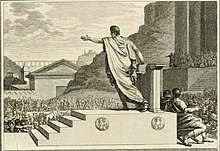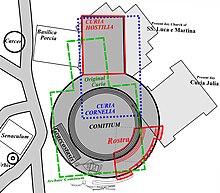

A tribune of the plebs (also called plebeian tribune; Latin: tribunus plebis) was a magistrate in the Roman Republic. According to the Roman annalistic tradition, the tribunes were created initially to protect the plebeians from abuse and advocate for plebeian interests with the patrician magistrates.[1] By the late republic, they were one of the most powerful civil magistrates in the city and an integral part of the republican constitution, with power to veto laws and senatorial decrees, intercede against prosecutions, and summon the concilium plebis to vote on legislation binding all Romans.
The plebeian tribunate was, through its whole history, open only to plebeians: patricians could not be elected unless they became plebeian first. Ten served every year during the classical republic with the full extent of their powers exercisable within the sacred boundary of the city (pomerium).
Powers
editIntercessio and auxilium
editLegislative powers
editHistory
editOrigins
editThe annalistic tradition dates the formation of the tribunate to c. 495 BC after a first secession of the plebs. There were initially two or five men elected; it places the establishment of the classical ten tribunes to the office's restoration in the aftermath of the Second Decemvirate (traditionally dated to 457 BC).[2]
Popularis tactics
editSulla's reforms
editDecline
editSee also
editReferences
edit- ^ Lintott 1999, p. 121.
- ^ Lintott 1999, p. 121: Livy, 2.33.2 starts with two, rising to five in 471 BC and ten in 457 BC. Livy, 2.58.1, 3.30.7. Dion. Hal. Ant. Rom., 6.89.1–2, 10.30.2 has five at the start and then ten in 449 BC. Diod. Sic., 11.68.8, instead has the number increase to four in 471 BC.
Bibliography
editModern sources
edit- Brennan, T Corey (26 October 2017). "tribunicia potestas". Oxford Research Encyclopedia of Classics. doi:10.1093/acrefore/9780199381135.013.8196. ISBN 978-0-19-938113-5.
- Cornell, Tim (1995). The beginnings of Rome. London: Routledge. ISBN 0-415-01596-0. OCLC 31515793.
- Derow, Peter Sidney (31 August 2016). "tribuni plebis". Oxford Research Encyclopedia of Classics. doi:10.1093/acrefore/9780199381135.013.6554. ISBN 978-0-19-938113-5.
- Drogula, Fred K (2017). "Plebeian tribunes and the government of early Rome". Antichthon. 51: 101–123. doi:10.1017/ann.2017.8. ISSN 0066-4774.
- Forsythe, Gary (2005). A critical history of early Rome. Berkeley: University of California Press. ISBN 978-0-520-94029-1. OCLC 70728478.
- Kondratieff, E J (2018). "Tribuni plebis". Encyclopedia of Ancient History. Wiley. pp. 1–5. doi:10.1002/9781444338386.wbeah20131.pub2. ISBN 978-1-4051-7935-5 – via ResearchGate.
- Lintott, Andrew (1999). Constitution of the Roman republic. Oxford University Press. ISBN 978-0-19-926108-6. Reprinted 2009.
- Lomas, Kathryn (2018). The rise of Rome. History of the Ancient World. Cambridge: Harvard University Press. doi:10.4159/9780674919938. ISBN 978-0-674-65965-0. S2CID 239349186.
- Steel, Catherine (2014). "The Roman senate and the post-Sullan "res publica"". Historia: Zeitschrift für Alte Geschichte. 63 (3): 323–339. doi:10.25162/historia-2014-0018. ISSN 0018-2311. JSTOR 24432812. S2CID 151289863.
- Smith, Christopher (2012). "The origins of the tribunate of the plebs". Antichthon. 46: 101–125. doi:10.1017/S0066477400000162. ISSN 0066-4774.
Ancient sources
edit- Dionysius of Halicarnassus (1937–50) [1st century BC]. Roman Antiquities. Loeb Classical Library. Translated by Cary, Ernest. Harvard University Press – via LacusCurtius.
- Livy (1905) [1st century BC]. . Translated by Roberts, Canon – via Wikisource.
External links
edit- Devereaux, Bret (25 August 2023). "How to Roman Republic 101, Part IIIc: Ten Tribunes, Two Censors and Twenty-Six Guys". A Collection of Unmitigated Pedantry.
- Media related to Ifly6/Plebeian tribune at Wikimedia Commons